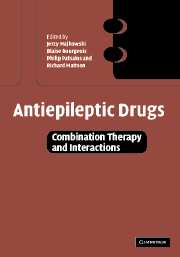Book contents
- Frontmatter
- Contents
- List of contributors
- Foreword
- Foreword
- Acknowledgements
- Part I Introduction
- Part II Pharmacokinetic interactions
- Part III Pharmacodynamic interactions
- 9 Pharmacodynamic principles and mechanisms of drug interactions
- 10 Methods for assessing pharmacodynamic interactions
- 11 Experimental studies of pharmacodynamic interactions
- 12 Clinical studies of pharmacodynamic interactions
- 13 Clinical studies of pharmacodynamic interactions between antiepileptic drugs and other drugs
- Part IV Drug interactions in specific patient populations and special conditions
- Part V Conclusions and future perspectives
- Index
13 - Clinical studies of pharmacodynamic interactions between antiepileptic drugs and other drugs
from Part III - Pharmacodynamic interactions
Published online by Cambridge University Press: 07 September 2009
- Frontmatter
- Contents
- List of contributors
- Foreword
- Foreword
- Acknowledgements
- Part I Introduction
- Part II Pharmacokinetic interactions
- Part III Pharmacodynamic interactions
- 9 Pharmacodynamic principles and mechanisms of drug interactions
- 10 Methods for assessing pharmacodynamic interactions
- 11 Experimental studies of pharmacodynamic interactions
- 12 Clinical studies of pharmacodynamic interactions
- 13 Clinical studies of pharmacodynamic interactions between antiepileptic drugs and other drugs
- Part IV Drug interactions in specific patient populations and special conditions
- Part V Conclusions and future perspectives
- Index
Summary
Introduction
Pharmacodynamic (PD) drug–drug interactions can occur when a patient receives concomitant treatment with two or more drugs. In general, the clinical effect resulting from PD interactions can be either advantageous or disadvantageous. A few studies in animal models have addressed the therapeutic or adverse synergistic effects of antiepileptic drugs (AEDs) (Meinardi, 1995). In humans, formal studies aiming to prove PD interactions between AEDs and other drugs are rare.
In this field, one of the most studied PD interactions is that occurring between flumazenil and benzodiazepines (BZD). Flumazenil is a specific and competitive antagonist of central BZD receptors, reversing all effects of BZD agonists. For this reason, incremental intravenous bolus injections of flumazenil are effective and well tolerated in the diagnosis and treatment of BZD overdose; treatment with flumazenil results in complete awakening with restoration of upper airway protective reflexes (Weinbroum et al., 1997). However, withdrawal symptoms and even seizures can be observed after administration of flumazenil in longterm BZD users; these symptoms may be avoided by a slow titration of flumazenil dose.
Alcohol is another substance whose PD interactions with sedative drugs have often been studied. Sedation, which is a typical adverse effect of many AEDs, is increased by the concomitant administration of alcohol in a way that has been described in different studies as either synergistic or additive (Kastberg et al., 1998).
Keywords
- Type
- Chapter
- Information
- Antiepileptic DrugsCombination Therapy and Interactions, pp. 241 - 254Publisher: Cambridge University PressPrint publication year: 2005
- 2
- Cited by

